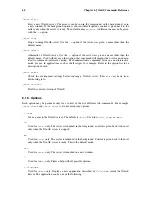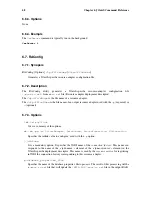
74
Chapter 7. Developing Session Beans
All the exceptions defined in the
throws
clause of an
ejbCreate
method must be defined in the
throws
clause of the matching
create
method of the home interface.
A
remote home interface
extends the
javax.ejb.EJBHome
interface, while a
local home interface
extends the
javax.ejb.EJBLocalHome
interface.
7.2.1. Session Bean Example:
The following examples use a Session Bean named
Op
.
public interface
OpHome
extends EJBHome {
Op
create
(String user) throws CreateException, RemoteException;
}
A local home interface could be defined as follows (
LocalOp
being the local component interface of
the bean):
public interface
LocalOpHome
extends EJBLocalHome {
LocalOp
create
(String user) throws CreateException;
}
7.3. The Component Interface
The Component Interface is the client’s view of an instance of the Session Bean. This interface
contains the business methods of the Enterprise Bean. If it is remote, the interface must
extend the
javax.ejb.EJBObject
interface; if it is local, the interface must extend the
javax.ejb.EJBLocalObject
interface. The methods defined in a remote component interface
must follow the rules for Java RMI (this means that their arguments and return value must be valid
types for Java RMI, and their throws clause must include the
java.rmi.RemoteException
). For
each method defined in the component interface, there must be a matching method in the enterprise
Bean’s class (same name, same arguments number and types, same return type, and same exception
list, except for
RemoteException
).
7.3.1. Example:
public interface
Op
extends EJBObject {
public void
buy
(int Shares)
throws RemoteException;
public int
read
()
throws RemoteException;
}
The same type of component interface could be defined as a local interface (even if it is not considered
good design to define the same interface as both local and remote):
public interface
LocalOp
extends EJBLocalObject {
public void
buy
(int Shares);
public int
read
();
}
Summary of Contents for Application Server
Page 1: ...Red Hat Application Server JOnAS User Guide ...
Page 8: ......
Page 22: ...14 Chapter 1 Java Open Application Server JOnAS a J2EE Platform ...
Page 58: ...50 Chapter 3 JOnAS Configuration ...
Page 66: ...58 Chapter 5 JOnAS Class Loader Hierarchy ...
Page 78: ...70 Chapter 6 JOnAS Command Reference ...
Page 80: ......
Page 86: ...78 Chapter 7 Developing Session Beans ...
Page 136: ...128 Chapter 9 Developing Message Driven Beans ...
Page 142: ...134 Chapter 10 Defining the Deployment Descriptor ...
Page 148: ...140 Chapter 11 Transactional Behavior of EJB Applications ...
Page 158: ...150 Chapter 14 EJB Packaging ...
Page 162: ...154 Chapter 15 Application Deployment and Installation Guide ...
Page 164: ......
Page 176: ...168 Chapter 18 WAR Packaging ...
Page 178: ......
Page 184: ...176 Chapter 20 Defining the Client Deployment Descriptor ...
Page 186: ...178 Chapter 21 Client Packaging ...
Page 188: ......
Page 192: ...184 Chapter 23 EAR Packaging ...
Page 194: ......
Page 200: ...192 Chapter 24 JOnAS Services ...
Page 204: ...196 Chapter 25 JOnAS and the Connector Architecture ...
Page 222: ...214 Chapter 27 Ant EJB Tasks Using EJB JAR ...
Page 234: ...226 Chapter 29 Web Services with JOnAS ...
Page 236: ......
Page 260: ...252 Chapter 34 How to use Axis in JOnAS ...
Page 270: ...262 Chapter 36 Web Service Interoperability between JOnAS and BEA WebLogic ...
Page 296: ......
















































